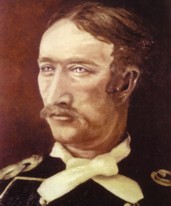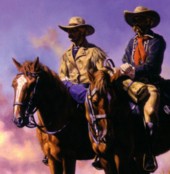
What does the average Custer aficionado know about Tom, George Armstrong Custer's younger brother? There are a few things which many Custer books mention: that he was the recipient of two Medals of Honor, awarded for the enemy flags he took during the American Civil War; that he received a hand wound at the Battle of Washita; that he may have fallen foul of Wild Bill Hickok; that he was involved in the arrest of Rain-in-the-Face, which resulted in the latter swearing he would kill Tom and eat his heart; and, of course, that he died with his brother on Custer Hill at the Battle of the Little Big Horn. In fact, almost everything well known about Tom happened during periods when his life overlapped with that of his brother (we might add to the above the famous fraternal wrestling matches; their shared interest in animals; Tom's appearance at GAC's court-martial; and other minor GAC-related occurrences, such as the occasion when Tom rescued him and Libbie Custer from a snow-bound train). Tom would probably not have minded this: he was very close to GAC and would not have been too bothered by history's perception of him as always in the shadow of his sibling. Yet this narrow approach of Custer historians has meant that those times of his life when Tom was not with his brother have been refused the recognition they deserve.
Astonishingly, Carl F. Day's Ride to Glory is the first book-length biography of Tom Custer. There have been a dozen or so articles and essays about him (starting with an emotional paean written by his sister-in-law, Libbie), but none of them has done him anything like full justice, and several repeat the same errors over and over again: no, one of his Medals of Honor was not awarded for an engagement on May 10, 1863, or April 2, 1865; no, he didn't enlist at the age of nineteen; and he wasn't at the Battle of Shiloh!
Thomas Ward Custer was born on March 15, 1845, in New Rumley, Ohio. A lively, even rambunctious boy, he was always an enthusiastic participant in the practical jokes which the whole family loved. In 1861, keen to emulate the brother he idolised (and who had recently gone from West Point to fight in the Civil War), Tom joined the 21st Ohio Infantry Regiment as a private, a few months after the War began, when he was only sixteen. He served in the Western Theater, seeing his first major action at Stones River (Dec 1862 - Jan 1863), and then becoming an orderly in the escort of a succession of generals. He did not join GAC in the Shenandoah Valley until late in 1864, by which time the end of the War was in sight. Second Lieutenant Tom Custer was awarded his two Medals of Honor for brave and impulsive actions at the Battles of Namozine Church (April 3, 1865) and Sailor's Creek (April 6, 1865). In the latter, he suffered a facial injury which proved to be of no great seriousness, although he seems to have borne the scar for the rest of his life. He received several brevet promotions for his War service, eventually attaining the brevet rank of lieutenant-colonel. After the War, he joined the 1st US Infantry, but quickly transferred to the newly formed 7th Cavalry, in which he served for all his remaining years, although not always under his brother. Following the Washita Campaign, there was a stint in South Carolina pursuing the Ku Klux Klan and moonshiners; then came the Yellowstone and Black Hills Expeditions, and finally Tom's death at the Little Big Horn. When his body was found, it was terribly mutilated, but his heart seems not to have been removed, so Rain-in-the-Face's threat was never carried out.
Carl Day very capably covers the whole of Tom's working life in the Army - from under-age private in the 21st Ohio to responsible captain in the 7th Cavalry. He devotes an especially welcome amount of space (despite the acknowledged paucity of sources) to the two periods so often neglected by other Custer writers: Tom's years during the Civil War before he became GAC's aide; and his time in the early 1870s in South Carolina on Reconstruction duty. Day has spent a decade conducting his research, a lot of it in primary material, as a result of which he never falls for the oft repeated errors of others, although a few minor mistakes have insinuated themselves into the text (e.g. Charles Griffen instead of Griffin), and I feel he might have made slightly greater use of the Official Records for the Civil War years.
It is in the area of Tom's personal life where the author's researches have reaped the most rewarding harvest. That Tom was a bit of a ladies' man has always been evident, but he remained unmarried and apparently childless to the end of his life. The regularly-reproduced photographs of him with the 'Wadsworth girls' are, we now discover, only the tip of the iceberg, and the story Day tells is in part a sad one, showing Tom to have been a good deal more than the happy-go-lucky, brave boy who became a decent officer with (as was so often the case) something of a drink and gambling problem. Two of the most fascinating revelations in Ride to Glory concern Thomas C. Custer, who was very likely Tom's illegitimate son by the daughter of an Ohio neighbour of Custer brother Nevin (Thomas Junior was probably fathered by Tom during a visit soon after the end of the Civil War); and Lulie G. Burgess, Tom's frail, consumptive fiancée, who tragically died in 1875 before they could marry.
A book-length biography of Tom Custer was a long time coming, and Carl Day's is unlikely to be superseded or improved upon for an equally long time. I have to admit, however, to disliking his tendency to pretend we can guess what Tom's thoughts, emotions and actions were in a given situation, without any supporting evidence. Thus, for instance, I could have done without the first two pages of Chapter One, in which Tom, lying among the dead and dying at Little Big Horn, sees his life flash before him; and also without descriptive lines based entirely on imagination (did Tom's red necktie truly "danc(e) in the cool morning breeze" at Five Forks?). There is a little too much of this and it feels like padding. Less of it and there might have been room for additional contemporary quotes from and about Tom (of which there are not really enough), and an expansion to the footnotes, bibliography and index. There might also have been more illustrations, but the fourteen included are well chosen; especially one photograph, completely unfamiliar to me, of Tom seemingly in his early teens.
A final question which we on this side of the Atlantic might want to ask is: was there ever any connection between Tom and Great Britain? Sadly, the answer is mostly a disappointing one, although, according to Libbie Custer, Tom did donate some rattlesnakes to "the 'Zoo' in London" (Following the Guidon, p.116). It would be interesting to know if any records of this transaction have survived.
By the way, in case you were wondering, the encounter between Tom and Wild Bill Hickok almost certainly never happened: it was, as Carl Day briefly but ably demonstrates, "a total fabrication".
(The portrait above is from the dust-jacket painting by Georgann Lautner.)

In His Brother's Shadow is such a poor book that I was almost inclined not to give it a review. What, after all, can one say about a 'biography' whose author admits to having included material from "some fiction works or nearly fictional secondary sources... in order to foster a taste for the era and places in which [Tom] lived" (he doesn't just mean background and scene-setting either, though that would be bad enough)? Or one in which the truth of the narrative takes second place to an attempt to interpret everything within the terms of a psychological syndrome (i.e. sibling rivalry)?
The single chapter devoted to Tom Custer's Civil War career contains many examples of both of these faults, and a notable shortage of those awkward little things: the facts. Over three years of Tom's time as a soldier in the Civil War were spent in the Western Theater, away from his brother, George Armstrong. This period gets a full half page of coverage, followed by about nine pages on the final few months of the War, during which Tom was Autie's aide and fought in the battles that brought him his two Medals of Honor. These pages are filled with unverified details and errors from secondary sources (and some mistakes of Bird's own making), plus conversation taken from fiction but quoted as though it really occurred. Many, much more trustworthy, primary and secondary sources are absent from the bibliography and references: Bird hasn't made any sort of attempt to acquire a full set of the various published articles on Tom Custer - some of which would certainly have proved useful to him; and for the Civil War years he hasn't even taken the obvious basic steps of obtaining Tom's personal service records, or using the Official Records to read up on the battles in which he was a participant.
There are similar problems with the rest of In His Brother's Shadow: take the chapter on Wild Bill Hickok, for instance. Bird describes at some length (from secondary sources, of course) the legendary set-to in 1870 between Hickok and Tom, an account which only the alert reader will notice is sprinkled with "supposedly", "allegedly", and suchlike hedgings! At the end he grudgingly admits that Tom may have had no involvement whatsoever in the events, and yet he asserts (without giving any evidence for it) that "Thereafter, Tom held little but contempt for Wild Bill"; while Autie went on to write glowingly about him. "For Tom," Bird says, "it was another grievance in the lop-sided rivalry with his brother". What?
I'm no expert on the Little Big Horn battle itself - far from it - but even I can see that there's something very wrong with Bird's entire reconstruction of what happened there. Perhaps it's because even I seem to have read at least half a dozen, more recent volumes on the subject than Bird has, judging from his bibliography.
Oh, and it's hard luck on anyone who goes to the book's index hoping to look up some information on Tom, or Autie, or Boston, or any other individual member of the Custer family. These are not differentiated, all being listed in a huge entry (with no subheadings) under the single word "Custer"! Heck, better to have saved space and just said "Custer, passim"! In fact, it's no more than the tip of the iceberg as far as the defects in this appallingly bad index are concerned: there are even separate index entries for typoes in the text ("Yellowtone River" anyone?).
In my review of Carl Day's Tom Custer: Ride to Glory, I wrote that (despite some flaws) Carl's biography of Tom was "unlikely to be superseded or improved upon for a... long time". There is no need for me to eat my words just yet!
(The picture of Tom and George Armstrong Custer above is a detail from the cover painting by Michael Schreck.)
Copyright (c) 2002, 2003 Rosemary
Pardoe.
Last altered: February 24, 2005.